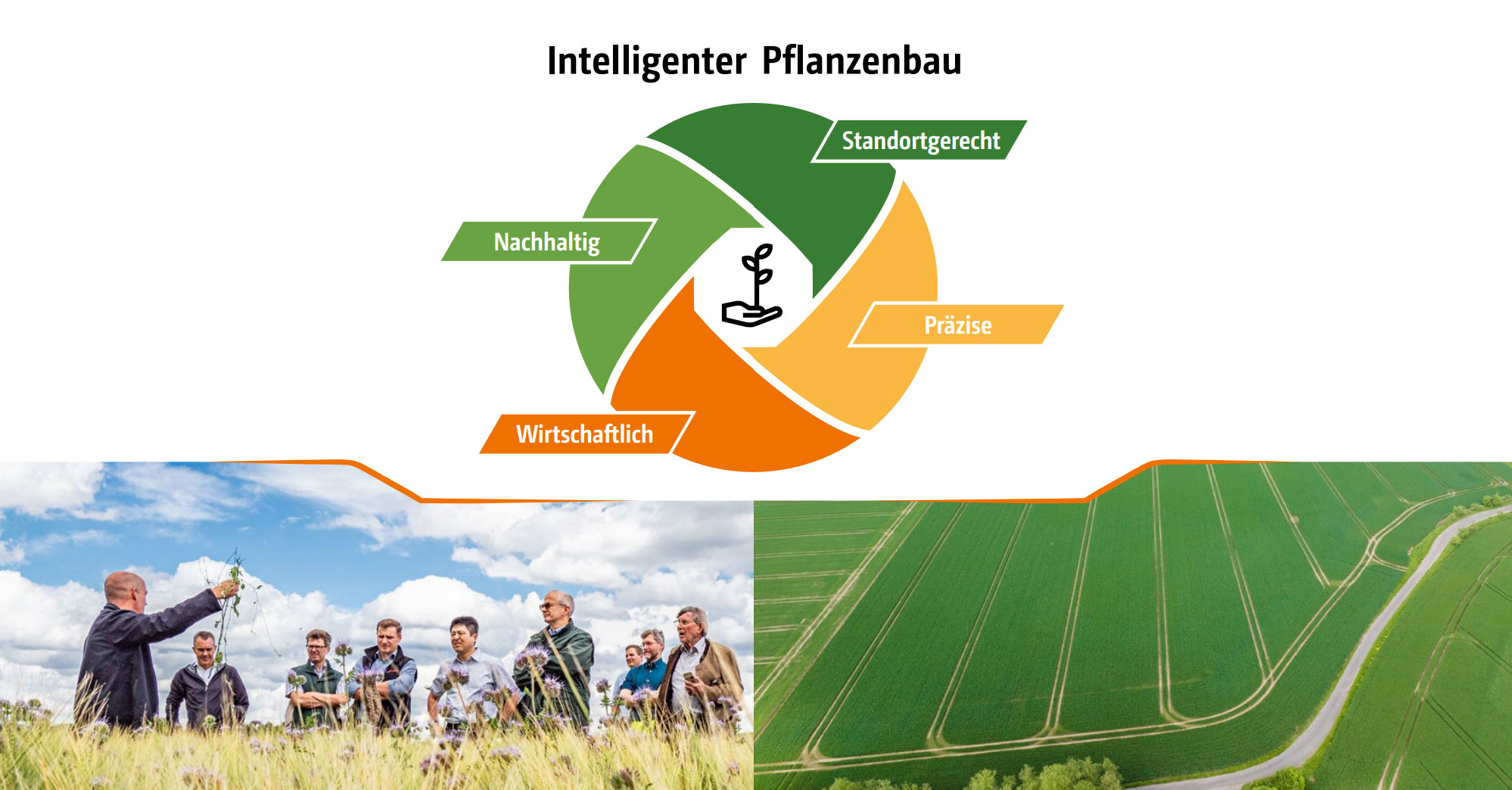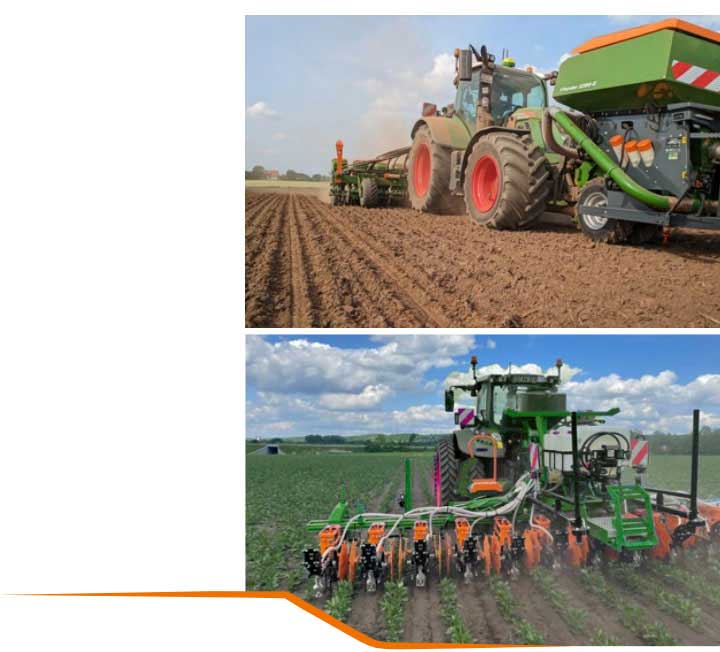Field trials at the AMAZONE trials centre in Wambergen
Welcome to the AMAZONE trials centre in Wambergen
Welcome to the AMAZONE trials centre in Wambergen.
This is where AMAZONE develops and tries out the latest agricultural and plant cultivation concepts.
Agriculture is only possible with commercial success in the long term. But the following is also true: There is no commercial success without sustainability, a concept which suits the local conditions and the precise and therefore more efficient use of inputs.
AMAZONE is developing intelligent crop production, in order to meet these new agricultural challenges with tailored solutions – as a basis for the development of innovative agricultural machinery and also as a basis for sustainable intensification to secure agricultural yields under all conditions.
Trials for the 2023/24 season
Trial 1: Controlled Row Farming – Row-based plant production concept
Trial 2: Optimum sowing in the mixed farming of maize with field beans, lupins or peas
Trial 3: Precision Farming - Variable crop management of winter wheat after rape
Trial 4: Comparison of methods for mulch sowing and direct seeding of winter barley after rape
Trial 1: Controlled Row Farming
A row-based plant production concept for higher efficiency and biodiversity
Apart from rising producer prices, the required reduction in the use of plant protection agents and fertilisers represents a major challenge for agriculture. Firstly, the environment must be protected and, secondly, yields must be secured at a high level. There are various ways of resolving this conflict of objectives – row-specific cultivation is one option.
What is required for this? In cooperation with SCHMOTZER Hacktechnik, DSV and AGRAVIS, AMAZONE is asking this question and testing the row-specific plant production concept Controlled Row Farming, in which the use of seed, fertiliser and plant protection agents is reduced and good yields obtained in spite of this. The approach: A lower plant density is compensated for by an improvement in the development of the individual plant, while the application quantities and costs for inputs are reduced overall.
A brief look at CRF
- Cultivation of all crops takes place at a fixed
- row spacing of 50 cm, cereals in a double row.
- Undersown crops suppress weeds, fix nitrogen and mobilise nutrients.
- More space promotes plant development and results in increased stress tolerance.
- Row offset of 25 cm allows positive crop rotation effects.
- Band spraying and fertiliser placement for the carefully directed use of inputs.
- Promotion of biodiversity may result in reduced yields.
- Further information:
www.controlled-row-farming.de/en/
Establishment
Volume sowing is carried out e.g. with an Avant combined with an FTender with a twin-chamber hopper or with the Precea precision air seeder from AMAZONE at a 50 cm row spacing. Undersown companion plants are either sown together with the winter crop or established after the main crop in the spring e.g. during the first mechanical weed control with SCHMOTZER hoes.
Crop management
A wide range of options: Full-area spraying against e.g. grasses, simultaneous hoeing with band spraying, concentrated application of liquid fertiliser in the row.
Results and challenges
Yields can generally be kept at a stable level. The reduced plant density is compensated for by higher tillering to a large extent. Costs are significantly reduced due to a reduction in the use of inputs, but the working time required is considerably higher. Automated agricultural machinery may remedy the situation, especially with respect to hoeing.
Trial 2: Mixed farming of maize with legumes
Comparison of the mixed farming of maize and field beans, lupins or peas within and between the row for increased biodiversity and utilisation of leguminous nitrogen fixation.
The objective of the trial is to test suitable sowing techniques for the establishment and management of the mixed crop. For this purpose, the project will investigate whether the combination of reduced crop protection treatment and companion plants provides adequate weed suppression as an alternative to herbicide use or hoeing. Options for the simultaneous harvest of mixtures will also be analysed.
Questions for the trial:
- Which sowing technique is best, in or between the row?
- Are weeds actively suppressed?
Trial 3: Precision Farming – variable crop management of winter wheat after rape
Variable crop management of winter wheat after rape with regard to sowing, fertilisation and plant protection (variable application rates in each case), depending on heterogeneous soil quality.
Technical solutions enable the fields to be cultivated according to their soil properties and yield potentials. The advantages are as follows: Inputs can be reduced or used more efficiently.
Questions for the trial:
- Are different fertilisation and plant protection strategies available?
- Is variable crop management worth the effort?
Trial 4: Comparison of methods for mulch sowing and direct seeding of winter barley after rape
Variant A: Mulching of the harvest residues, total herbicide, direct seeding with Primera DMC.
Variant B: Shallow and deep soil tillage with Catros and Cenius, followed by sowing with Avant seed drill.
Wide-ranging discussion on future strategies in soil tillage against the backdrop of changing climatic, political and plant cultivation challenges.
Questions for the trial:
- Is a single plant protection strategy possible?
- Which yields are obtained, are there any advantages from the business management standpoint?
Reduced soil tillage can:
- lead to savings in costs, working time and fuel consumption
- lead to reduced investment in machines and tractors
- but also lead to higher weed infestation and therefore require higher herbicide use.






